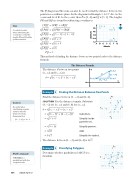Page 579 - Algebra 1
P. 579
The Pythagorean Theorem can also be used to find the distance between two points in a coordinate plane. In the diagram for Example 1, let 1st Ave. be the x-axis and let A St. be the y-axis; then P is (1, 4) and Q is (5, 1). The lengths PR and RQ are found by subtracting coordinates.
5th 4th 3rd
2nd 1st
(PQ)2 = (PR)2 + (RQ)2
Hint
Use absolute value
when subtracting the coordinates so that the lengths PR and RQ will be positive numbers.
P (1,
4)
R (5, 4)
Q (5,
1)
√(PQ)2 = √(PR)2 + (RQ)2
√(PQ)2 = √⎢5 - 1 2 + ⎢1 - 4 2 √
√(PQ)2= 42+32 2
√(PQ) =√16+9
A B C D E F G
Streets
2
√ √(PQ) = 25
PQ = 5
This method of finding the distance between two points leads to the distance
formula.
The Distance Formula
The distance d between two points (x1, y1) and (x2 ,y2) is
d = √(x2 - x1 )2 + (y2 - y1)2.
y
(x1, y1)
⎪x
d
2
x ⎥ 1
(x2, y2)
⎪ ⎪ y y 2 2 y y 1 1⎥ ⎥
(x2, y1)
x
Example
2
Finding the Distance Between Two Points
Find the distance between (3, -2) and (6, 4). SOLUTION Use the distance formula. Substitute
(3, -2) for (x1, y1) and (6, 4) for (x2, y2).
Substitute.
Simplify inside parentheses.
Simplify powers. Add.
Simplify the radical.
Caution
Be careful when substituting negative numbers into the distance formula. Remember that
(4 - (-2)) = 4 + 2.
√(x2 - x1)2 + (y2 - y1 )2
d =
= √(6 - 3)2 + (4 - (-2))2
= √ 3 2 + 6 2
= √ 9 + 3 6
= √ 45
= 3 √ 5
The distance between (3, -2) and (6, 4) is 3√5 . Classifying Polygons
Determine whether quadrilateral ABCD is a rhombus.
Example
3
Math Language
A rhombus is a quadrilateral with four congruent sides.
564 Saxon Algebra 1
8
y
(6, 4)
4
d
x
-8
-4
8
-4
(3,
-2)
-8
4
y
B(2, 1)
A(-1, 0)
2
x
-4
-2
2
-2
C(1, -2)
D(-2,
-3) -4
Avenues


